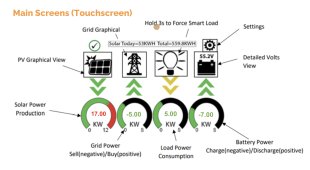So I have 4x “48v 10a” power supplies, ostensibly 500w each. 3 of them are ‘fixed’ 48v with just a trim pot and wont go past 49.x volts, one is a 0-48 model which will go almost to 53v. Also have a 60v 7ish amp i run off my 12v system into the 48v sometimes, and 4x 100w 54.6v little charge cords. All this feeds into the same set of bus bars which is hooked to my 48v system.
The reason for the mix of voltages etc is because if you use a voltage you actually expect your pack to reach there is considerable variability of how much power is consumed and delivered between each side of things. The little 100w 54v units will never bring my system to 54 volts, so they stay ~100w for as long as they’re on. I usually use those to feed from the ~5kwh lifepo4 120v system in my Rv into my 48 house pack overnight to ‘shift cycles’ from the fla to the lifepo4, and i bought 4x 100w instead of a 400w because it let me experiment in 100w increments. Ive seen those as low as $8/ea on amazon. The 60v ~7a (~$30) is likewise ‘always’ 400w and runs off a 12v inverter hooked to my silly 12v bus of cars and tractors parked outside my house. ? Im essentially using voltages as a cheap hack for not buying things with adjustable current limiting.
The 49v psu’s (30-something $) may actually push the system to 49 and when hooked to my generator that’s ideal because i dont actually want my generator use to get ‘even more ridiculously inefficient’ by trying to actually charge my large FLA pack at FLA charging efficiencies, off gasoline. My thinking is that if you are using the power as you make it, you are not subjecting that power to an extra conversion/efficiency loss by actually trying to put it in your battery before you use it. It is just going on the 48v bus and ‘offsetting’ battery consumption by however much it can supply, and if the load drops off to the point that the system raises to ~49 the psu’s ‘idle’ at a few watts each and my generator essentially ‘idles’ as well, although this is a cheap non-inverter gen so its still out there churning 3600rpm at no load, sadly.
If i turn them all on at once (3 switches) it’s ~3kw into my 48v system and doesnt require me to do anything on the 48v side, change any settings flip any disconnects etc. Ac bypass irritates me on my Growatts so im avoiding it with this setup. I used to use a 5kw gas generator into growatts and it was too loud, too thirsty, and required me to spend too much time thinking about what i was doing on the loads side and wouldn’t actually charge batteries anyway unless i didnt plan to do a single thing that would push the 5k gen past its comfort zone. It was something that required me to be aware of it basically the whole time it was happening. On the other hand, between a 3500w generator running at less than max making considerably less noise and never ever overloading, 5kwh in my rv and untold kwh in the >12+ vehicles hooked up outside which would also mostly charge that system at 600-700w each if i wanted a car engine running, I just dont realy have to think about those systems when they’re on. The 12v ‘feeds’ operate at basically fixed rates that i can ballpark kwh with a couple seconds of mental math and then ignore for that many hours. The generator feed basically only comes up if i want to run the clothes drier with no sun, in which case i turn it off when im done and am fairly convinced i havent used much more gas than i really had to because if it went above 49v it just ‘idled’.
Its just one big science experiment done incrementaly with the cheapest stuff i could get my hands on as ‘proof of concept’ of my crazy thoughts, and now that it’s proven it may get ‘upgraded’ with better components if it ever breaks. But, my experience so far is that if a fan doesnt fail (which they do, cheap stuff) and the units are oriented and spaced for airflow they do seem to be able to run at max output for long periods. The outputs are hooked to the 48v system 24/7 so no damage from ‘pre-charge’ issues and i suspect that softens the inrush on the AC side as well. The ones that are hooked to gen are plugged in before its ever running and i suspect the 0-3600rpm runup softens the inrush there as well. So i think they are being treated better than some of the early 12v 30a models which i did kill parts on but mostly seemed to come down to ‘connections etiquette’ of how they were hooked or unhooked from power.
So there’s an essay.. lol



